Can you grow a potato from a potato? Expert tips on the dos and don'ts of this growing method
Using seed potatoes is a tried-and-tested method for success, but what about growing store-bought potatoes or replanting ones from a previous harvest? Our experts advise...
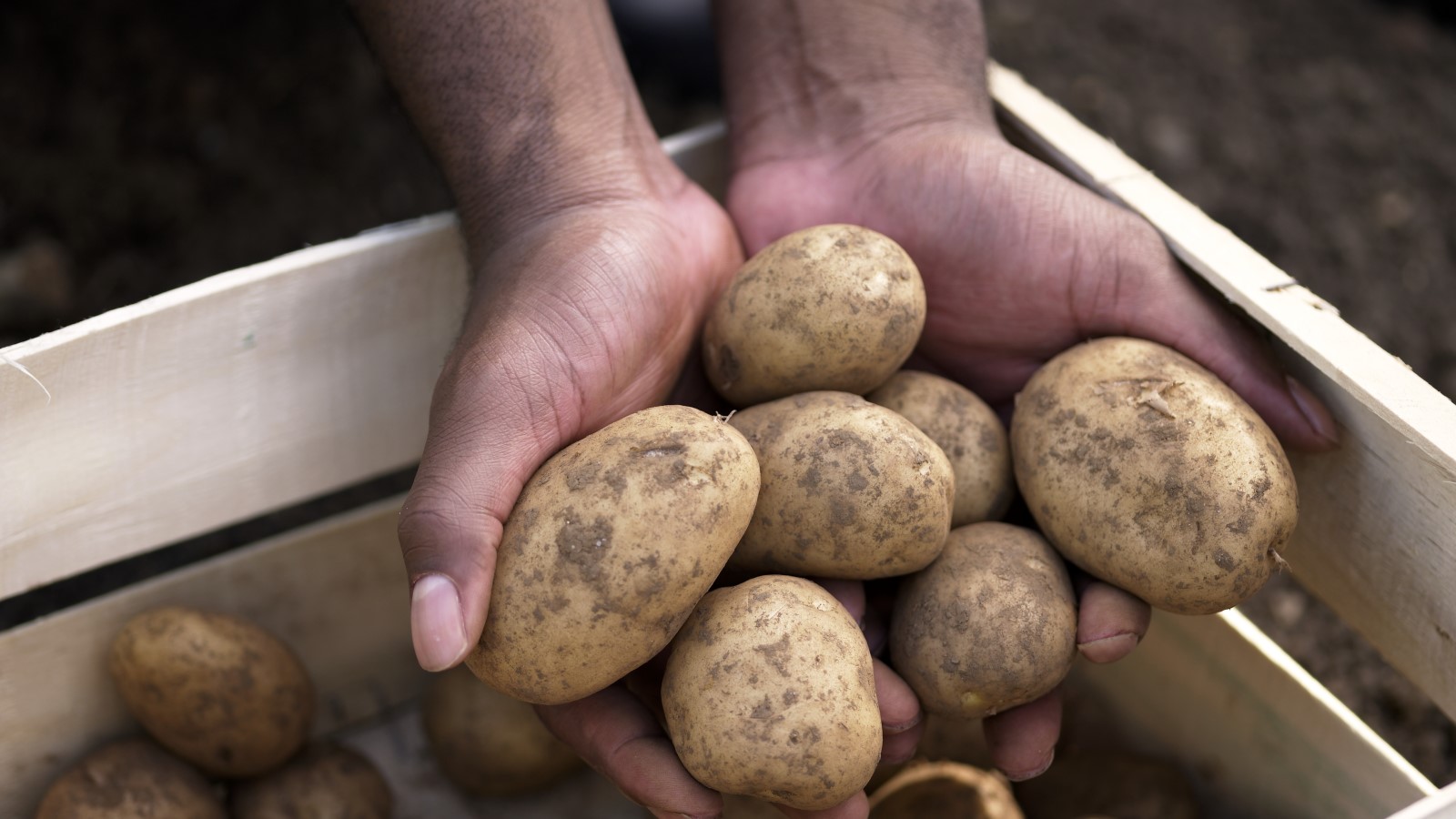

It is simple to grow a potato from a potato. Each individual potato contains all it needs to grow a new plant, it has eyes to sprout and the tubers contain all the energy and nutrients required. It may be simple, but is it recommended?
There is one main universally approved way to grow potatoes from a potato, and some riskier alternatives.
When planning how to grow potatoes using one (or more) of these methods, take into consideration what the experts advise and reflect on what is best for your vegetable garden as a whole – it might not be worth taking a chance.

Certified disease-free seed potatoes are the best way to go

Drew is a journalist and former professional gardener. He worked in productive kitchen gardens in the UK growing a wide range of vegetables year-round for chefs. He has grown potatoes for over a decade, at work, on an allotment, and at home in containers and bags.
What is the best way to grow potatoes from a potato?
The simplest answer of how to grow a potato from a potato is to purchase seed potatoes to grow your crop from. Seed potatoes are commonly available in stores and specialist websites and it is the number one recommended way to grow potatoes. Look out for USDA recognized seed potatoes that are certified disease-free.
Any seed potatoes will be one that has been bred to be grown and replanted. Growers get these seed tubers and traditionally start chitting potatoes in order to get an earlier harvest. In a nutshell, growing potatoes from a seed potato is the fastest and most reliable way to grow potatoes and anyone wanting to grow tubers is highly advised to follow this route.
Seed potatoes are available to buy from Burpee.
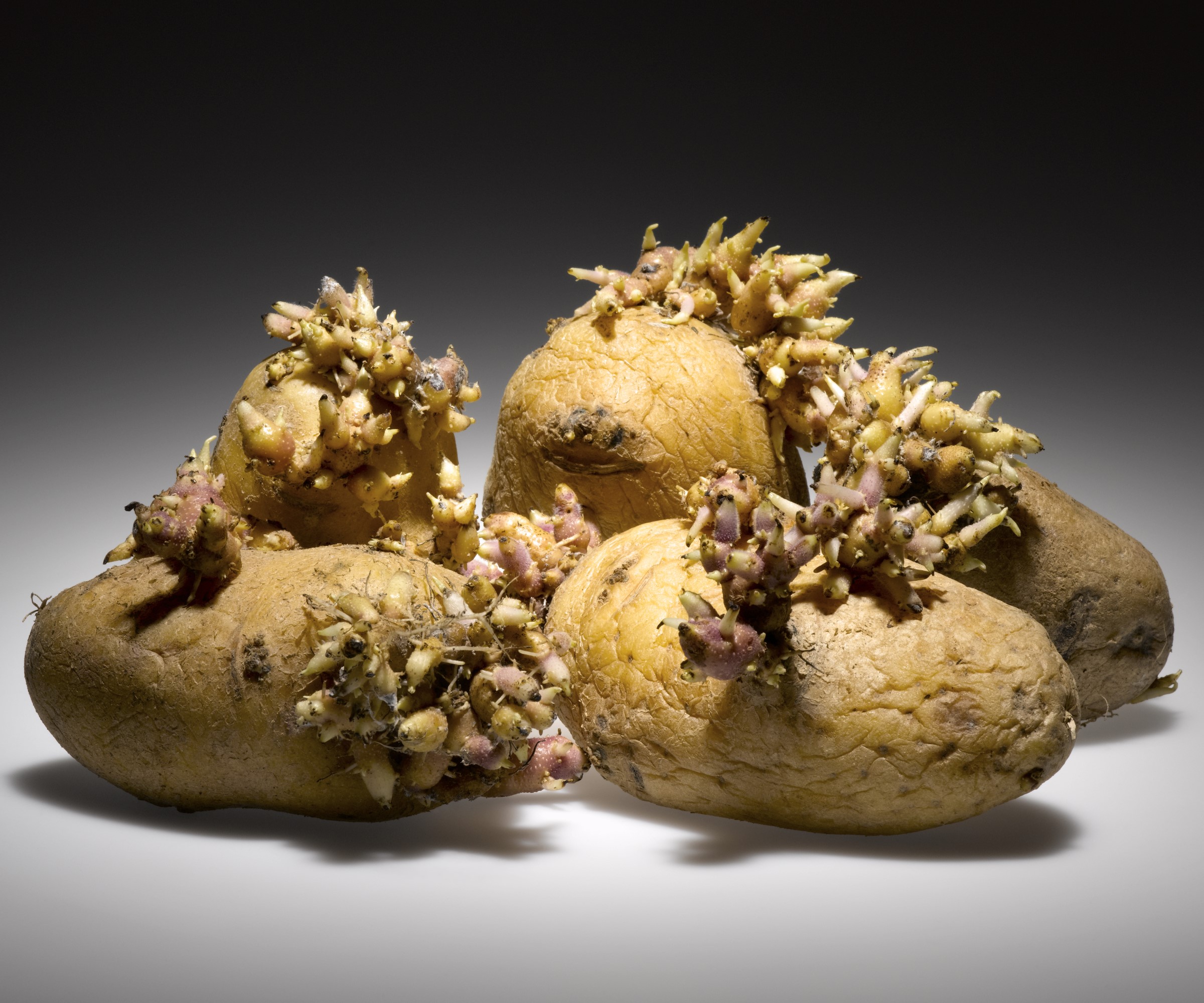
Potatoes will sprout if they are stored in the dark, or left in the ground
Should I plant a potato from the grocery store?
It is not advised to grow potatoes from potatoes you bought at the store. Technically, it can be done as many potatoes you buy are likely to sprout eventually. Anyone who discovers a long-forgotten bag of potatoes at the back of a cupboard is likely to have seen it develop shoots. However, there are many experts who advise against planting such tubers.
Jo Ellen Meyers Sharp from Hoosiergardener says: ‘Yes, you can plant and grow a potato from the grocery store, but it’s not recommended. Potatoes from the grocery store have likely been treated with a growth retardant to keep them from sprouting.’
Susan Mulvihill, author of ‘The Vegetable Garden Problem Solver Handbook’ – available to buy on Amazon – adds that most of the non-organic potatoes are treated with chlorpropham and, as well as inhibiting sprouting, it also impedes normal growth if they are planted out and causes them to struggle.
But what about using organic store-bought potatoes? Susan has words of warning for anyone thinking organic potatoes are assured safe to plant in the backyard.
‘It's unlikely that organic potatoes are sprayed with chlorpropham but here's another compelling reason to avoid using organic (or non-organic) grocery store potatoes in your garden: the potatoes sold in stores are not screened for diseases,' she adds.
‘Potatoes belong to the Nightshade family (Solanaceae) along with tomatoes, eggplants, peppers and tomatillos. All of these crops are susceptible to the same types of diseases, so in addition to taking chances with your potato crop, you're also putting those other crops at risk of disease.’
The risk of disease is a warning echoed by Christy Wilhelmi, the founder of organic gardening resource Gardenerd, who adds: ‘Grocery store potatoes are not certified disease-free, so the likelihood of planting potatoes that develop blight is high. Once blight is in your soil it's hard to eradicate. Better to start with certified disease-free seed potatoes.’
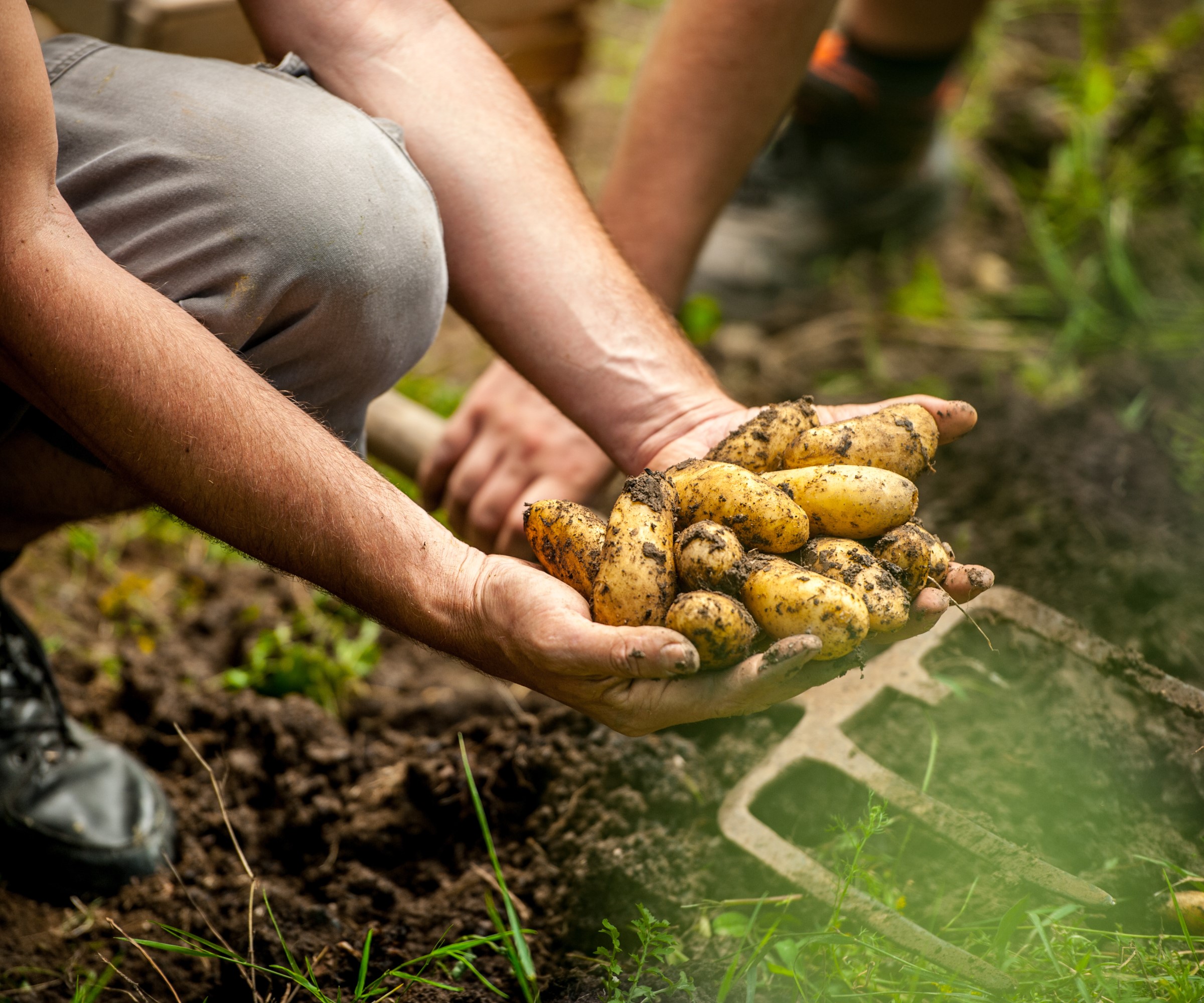
Healthy reputable tubers should give a good yield without the risks
Can you replant harvested potatoes to grow new ones?
Many growers may have considered that, when it’s time to harvest potatoes, they can hold some back to re-plant again and grow another crop. Lots may have even done it and succeeded. Steering away from seed potatoes and saving your own potatoes can save money, but does it come at a risk too?
John Negus, expert for Amateur Gardening, warns that potatoes harvested at the end of their natural growing season will not necessarily work as well as tried-and-trusted specially bred seed potatoes.
‘The seed potatoes that you buy at this time of year have had their growth suppressed since they were harvested,’ he adds. ‘Potatoes harvested at the end of their natural growing season will have gone dormant with the change in the season and may not come into growth when planted.
‘The more important consideration is that seed potatoes are specially bred and certified to be free from viruses. Healthy tubers are essential to be sure of a good yield and harvested potatoes may carry these viruses that will be passed into the crop.’
If you aspire to re-plant tubers then knowing how to store potatoes is a must. The lifted potatoes need to be stored at a right temperature at around 35-40˚F in order to rest. Potatoes have a natural dormancy period of 4-8 weeks after harvest. Incorrect temperatures can cause the potato to break its dormancy and initiate early sprouting.
Crop rotation is vital if you do use your own seed potatoes. By rotating where you grow your potatoes and other crops you can prevent any build-up of disease within the soil that can affect future plants in that area.
Practically every grower and gardener knows how to harvest potatoes, however many are likely to have missed a few potatoes in the ground come harvesting time. These lost potatoes will do everything they can to grow more potatoes. Any tubers left in the ground will often sprout, and you will see new plants popping up in areas you previously planted the crop in, potentially for a few years after. These potato tubers left in the ground will sprout and start trying to grow new potatoes – though there is no guarantee that you will get a good harvest.
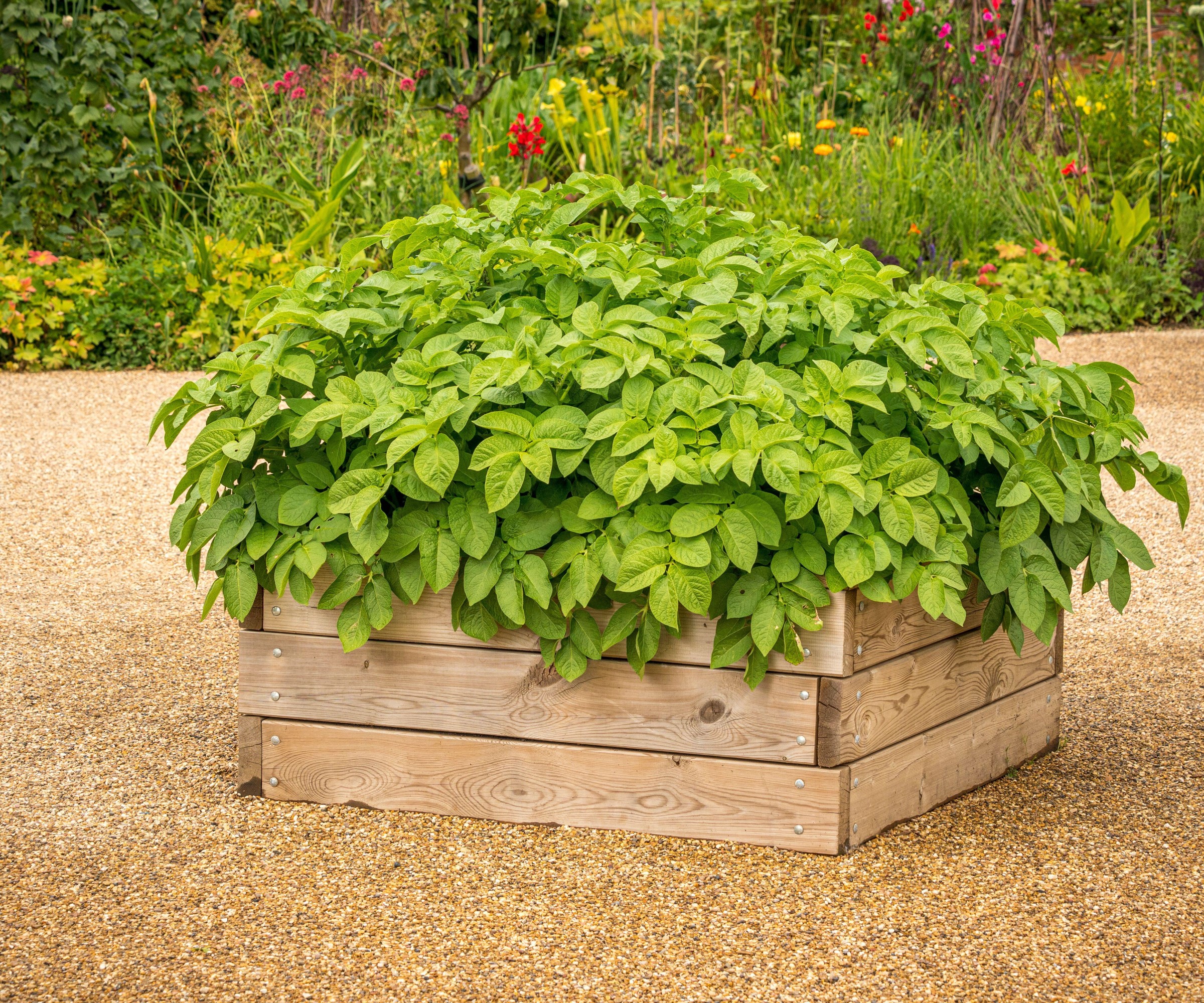
Potatoes are perfectly suited to successfully grow in containers
Growing potatoes from potatoes in a container
Using seed potatoes to start your crop is always the recommended route to follow. However, if you do want to try planting your own saved seed potatoes, or even store-bought potatoes, then it is best to grow them in containers, pots, or bags. This can reduce, but not eliminate, the risk of spreading disease as crops can be grown away from other plants and the soil in the container thrown away afterwards.
The method for growing potatoes in a container is simple to follow and means you can grow potatoes without a yard, such as in a courtyard or on a balcony. Whatever container you choose, the general method is the same and requires simply some soil, a few potatoes, and a little bit of care and patience.
To grow potatoes in a bag, the important thing is good drainage and to ensure the sides exclude light. You can buy dedicated potato bags or simply use black plastic bags you may have at home.
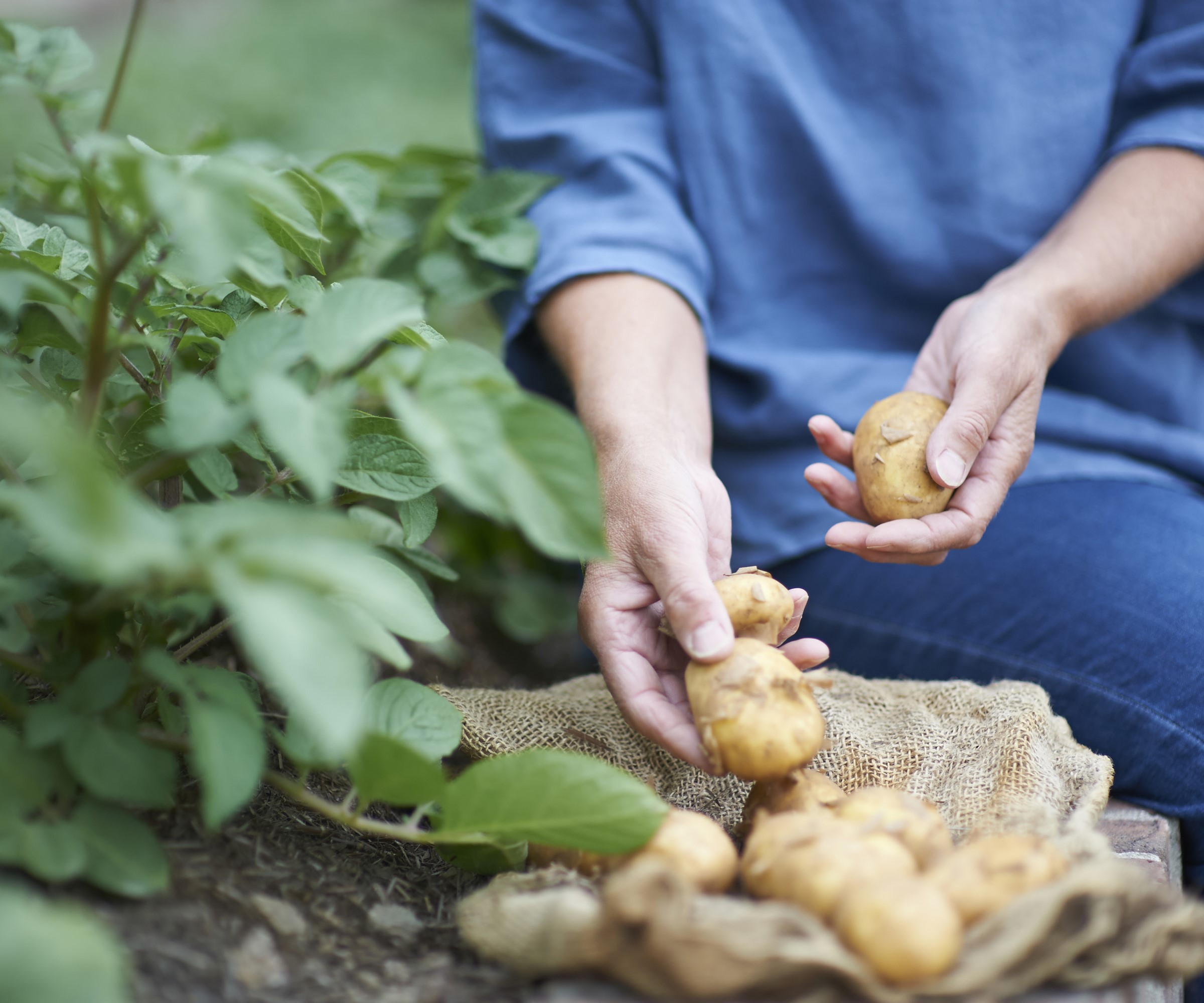
Harvesting the first potatoes is a joyful time in a growers year
Can you grow a potato from a potato in water?
You can sprout a potato in water, but not grow a potato in water. The sprouted tuber needs to be planted out in the yard in your vegetable garden, or into a pot, to grow on and develop into a full plant that can be harvested.
It is a simple process to achieve and a task that is common for school projects. Fill a jar with a few inches of water and submerge part of a potato in there, with some eyes on the potato pointing upwards. You can use toothpicks to help suspend the potato partially in the water.
Place the potato in a sunny spot and sprouts should appear within a few weeks. Check and top-up the water regularly to ensure the potato remains submerged and change the water if it gets cloudy. The sprouting tuber can be taken out of the jar and planted in soil to grow on and hopefully provide a harvest down the line.
How long does it take for a potato to sprout from a potato?
It can take from two to four weeks for sprouts to emerge from a potato, depending on temperature and conditions. Potatoes will sprout at a minimum of 40˚F but will sprout best at temperatures of 65-70˚F. If you are chitting potatoes, it is recommended to start them off four to six weeks before you intend to plant the potatoes outdoors.
Sign up to the Homes & Gardens newsletter
Design expertise in your inbox – from inspiring decorating ideas and beautiful celebrity homes to practical gardening advice and shopping round-ups.

Drew’s passion for gardening started with growing vegetables and salad in raised beds in a small urban terrace garden. He has worked as a professional gardener in historic gardens and specialises in growing vegetables, fruit, herbs, and cut flowers as a kitchen gardener. That passion for growing extends to being an allotmenteer, garden blogger, and producing how-to gardening guides for websites. Drew was shortlisted for the New Talent of the Year award at the 2023 Garden Media Guild Awards.
-
 Ina Garten's storage pantry is an insightful window into all of the best cookware used by the chef – and it's easy to recreate on your kitchen shelves from $48
Ina Garten's storage pantry is an insightful window into all of the best cookware used by the chef – and it's easy to recreate on your kitchen shelves from $48The beautiful dishware in The Barefoot Contessa's Hamptons pantry showcases the tools she uses most often to cook – this is exactly how you replicate it
By Sophie Edwards Published
-
 Extend the lifespan of your appliance with 5 simple but crucial washing machine maintenance tips
Extend the lifespan of your appliance with 5 simple but crucial washing machine maintenance tipsFrom cleaning the filters to keeping the door open, experts reveal the washer tips they swear by
By Andy van Terheyden Published